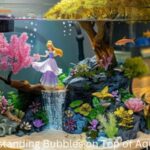Equipment and Maintenance
How to Remove Nitrite from Aquarium: A Comprehensive Guide
How to Remove Nitrite from Aquarium? Nitrite is a toxic compound that can pose significant risks to your aquarium’s inhabitants if not properly managed. Understanding how to effectively remove nitrite from your aquarium is crucial for maintaining a healthy and stable aquatic environment. This article Guide to Fish Raising provides a detailed guide on the causes of nitrite accumulation, preventive measures, and effective methods to eliminate nitrite from your aquarium.
Table of contents
ToggleUnderstanding Nitrite in Aquariums
What is Nitrite?
Nitrite (NO2-) is a chemical compound that is part of the nitrogen cycle in aquariums. It is produced during the breakdown of ammonia by beneficial bacteria through a process known as nitrification. Nitrite is then further converted into nitrate (NO3-) by other bacteria. While nitrate is relatively less harmful, nitrite is highly toxic to fish and other aquatic life.
Why is Nitrite Harmful?
Nitrite interferes with the ability of fish to absorb oxygen, leading to a condition known as methemoglobinemia or “brown blood disease.” This condition reduces the oxygen-carrying capacity of the blood, causing fish to become stressed, lethargic, and in severe cases, it can be fatal.
Causes of Nitrite Accumulation
Overfeeding
Description: Excess food decomposes in the aquarium, leading to increased ammonia production, which subsequently raises nitrite levels.
Solution: Feed your fish sparingly and remove any uneaten food after feeding sessions. A general rule is to only feed what your fish can consume within 2-3 minutes.
Overcrowding
Description: Too many fish in an aquarium can lead to excessive waste production, overwhelming the biological filtration system.
Solution: Ensure your tank is appropriately stocked. Follow guidelines on the recommended number of fish per gallon of water, and consider the specific needs of each species.
Inadequate Filtration
Description: An insufficient or malfunctioning filtration system can fail to process ammonia and nitrite effectively.
Solution: Use a high-quality filter that provides mechanical, chemical, and biological filtration. Regularly clean and maintain your filter to ensure optimal performance.
Cycling a New Tank
Description: New tanks often experience “new tank syndrome,” where beneficial bacteria colonies have not yet fully established, leading to nitrite spikes.
Solution: Cycle your aquarium properly before adding fish. This process can take several weeks and involves adding an ammonia source and monitoring the development of beneficial bacteria.
Dead Plants and Animals
Description: Decomposing plants, uneaten food, and dead fish release ammonia, which is then converted to nitrite.
Solution: Regularly remove dead plant material and any deceased fish or invertebrates from the tank. Perform routine maintenance to keep the tank clean.
Testing for Nitrite

Importance of Regular Testing
Regularly testing your aquarium water for nitrite is crucial for early detection and prevention of nitrite poisoning. Testing allows you to monitor the effectiveness of your filtration system and adjust maintenance routines as needed.
Testing Kits
Types: Use liquid test kits or test strips to measure nitrite levels in your aquarium. Liquid test kits are generally more accurate, but test strips are convenient for quick checks.
Frequency: Test your water at least once a week, and more frequently if you suspect a problem or are cycling a new tank.
Understanding Results
Safe Levels: Nitrite levels should ideally be zero in a healthy, established aquarium. Levels above 0.5 ppm are dangerous and require immediate action.
Preventive Measures
Proper Tank Cycling
Fishless Cycling: Before adding fish, cycle your tank using an ammonia source. This allows beneficial bacteria to establish without putting fish at risk.
Patience: Be patient during the cycling process. It can take several weeks for the tank to stabilize, but this is crucial for long-term success.
Optimal Feeding Practices
Moderation: Feed your fish sparingly to avoid overfeeding. Provide a varied diet to meet their nutritional needs without excess waste.
Observation: Observe your fish during feeding to ensure they are eating all the food provided. Adjust the amount based on their consumption.
Regular Maintenance
Water Changes: Perform regular water changes, typically 20-25% weekly, to dilute waste and remove nitrite. Use a gravel vacuum to clean the substrate.
Filter Maintenance: Clean filter media according to the manufacturer’s instructions, and replace it when necessary. Do not clean all filter media at once to preserve beneficial bacteria.
Quarantine New Additions
Isolation: Quarantine new fish and plants for at least two weeks before introducing them to the main tank. This prevents the introduction of pathogens and allows for observation.
Treatment: Treat quarantined fish for parasites and diseases if necessary before adding them to the main tank.
Methods to Remove Nitrite
Water Changes
Frequency: Perform large water changes (50% or more) in cases of high nitrite levels. Continue with regular smaller water changes until levels normalize.
Technique: Use a dechlorinator to treat tap water before adding it to the tank. Ensure the new water matches the temperature and parameters of the tank water.
Biological Filtration
Beneficial Bacteria: Enhance biological filtration by adding bacteria supplements or using products containing live nitrifying bacteria.
Media: Use high-quality bio-media in your filter to provide ample surface area for beneficial bacteria to colonize.
Chemical Filtration
Nitrite Removers: Use chemical filtration products specifically designed to remove nitrite from the water. Follow the manufacturer’s instructions carefully.
Activated Carbon: Activated carbon can help remove dissolved organic compounds that contribute to nitrite production, but it is not a direct nitrite remover.
Live Plants
Benefits: Live plants can absorb ammonia and nitrite, aiding in maintaining water quality. They also compete with algae for nutrients, reducing algae growth.
Species: Choose fast-growing plants like hornwort, water sprite, and duckweed, which are effective at absorbing nitrogen compounds.
Salt Treatment
Dosage: Adding aquarium salt at a rate of 1 tablespoon per 5 gallons can help reduce the toxicity of nitrite to fish. Salt reduces nitrite uptake by the fish.
Precautions: Use non-iodized aquarium salt and avoid overuse. Monitor fish closely for any adverse reactions, as some species are sensitive to salt.
Case Studies and Real-Life Experiences
Case Study 1: Overcrowded Community Tank
A hobbyist with an overcrowded community tank noticed lethargy and rapid breathing in their fish. Testing revealed high nitrite levels. The aquarist performed several large water changes, reduced feeding, and rehomed some fish to lower the bioload. Within a week, nitrite levels dropped to safe levels, and the fish’s health improved.
Case Study 2: New Tank Syndrome
A beginner aquarist set up a new tank and added fish too soon, leading to a nitrite spike. The fish exhibited stress and fin clamping. The aquarist added a bacteria supplement and performed daily water changes. They also adjusted feeding and waited for the tank to fully cycle. The tank stabilized after three weeks, and the fish thrived.
Case Study 3: Plant-Enhanced Filtration
An aquarist with a heavily planted tank noticed a gradual increase in nitrite levels. They increased the number of fast-growing plants and adjusted the lighting to enhance plant growth. The plants absorbed excess nitrogen compounds, and nitrite levels returned to zero without chemical treatments.
Conclusion
Removing nitrite from your aquarium is essential for maintaining a healthy environment for your fish. By understanding the causes of nitrite accumulation, implementing preventive measures, and applying effective removal methods, you can ensure the well-being of your aquatic pets. Regular testing, proper tank maintenance, and patience are key to managing nitrite levels and creating a thriving aquarium ecosystem.





